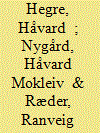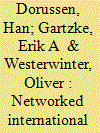|
|
|
Sort Order |
|
|
|
Items / Page
|
|
|
|
|
|
|
| Srl | Item |
| 1 |
ID:
138830


|
|
|
|
|
| Summary/Abstract |
Theories of conflict diffusion have long argued that domestic conflict spreads from one country to others. One set of mechanisms explaining this relies on material flows across borders that incite violence in neighboring countries. Another set of mechanisms, however, relies on informational flows. Information about ongoing violence elsewhere triggers strategic learning and demonstration effects in subnational conflict actors which may increase the likelihood that these actors ultimately resort to violence. While the first set of mechanisms can be – and has been – assessed using spatial proximity to define connections between countries, this article provides a test of the second mechanism by analyzing communication flows. The article shows that the occurrence of ethnic conflict in a country’s main communication partners significantly increases the probability of domestic ethnic violence, and that this effect operates in conjunction with, and is at least as strong as, the spatial contagion effect of conflict in the geographic neighborhood.
|
|
|
|
|
|
|
|
|
|
|
|
|
|
|
|
| 2 |
ID:
152301


|
|
|
|
|
| Summary/Abstract |
Several studies show that internal armed conflict breeds conflict by exacerbating conditions that increase the chances of war breaking out again. Empirically, this ‘conflict trap’ works through four pathways: conflicts increase the likelihood of continuation, recurrence, escalation, and diffusion of conflict. Past empirical studies have underestimated the scope and intensity of the conflict trap since they consider the impact of conflict only through one of these pathways and rarely across sufficiently long time periods. This article shows that simulation and forecasting techniques are useful and indeed necessary to quantify the total, aggregated effect of the conflict trap, over long time periods and across countries. We develop a country-year statistical model that allows estimating the probability of no conflict, minor conflict, and major conflict, and the probabilities of transition between these states. A set of variables denoting the immediate and more distant conflict history of the country are used as endogenous predictors in the simulated forecasts. Another set of variables shown to be robustly associated with armed conflict are treated as exogenous predictors. We show that the conflict trap is even more severe than earlier studies have indicated. For instance, if a large low-income country with no previous conflicts is simulated to have two to three years of conflict over the 2015–18 period, we find that it will have nine more years of conflict over the 2019–40 period than if peace holds up to 2018. Conversely, if a large low-income country that has had major conflict with more than 1,000 battle-related deaths in several of the past ten years succeeds in containing violence to minor conflict over the 2015–18 period, we find that it will experience five fewer years of conflict in the subsequent 20 years than if violence continues unabated.
|
|
|
|
|
|
|
|
|
|
|
|
|
|
|
|
| 3 |
ID:
145690


|
|
|
|
|
| Summary/Abstract |
Network theory and methods are becoming increasingly used to study the causes and consequences of conflict. Network analysis allows researchers to develop a better understanding of the causal dynamics and structural geometry of the complex web of interdependencies at work in the onset, incidence, and diffusion of conflict and peace. This issue features new theoretical and empirical research demonstrating how properly accounting for networked interdependencies has profound implications for our understanding of the processes thought to be responsible for the conflict behavior of state and non-state actors. The contributors examine the variation in networks of states and transnational actors to explain outcomes related to international conflict and peace. They highlight how networked interdependencies affect conflict and cooperation in a broad range of areas at the center of international relations scholarship. It is helpful to distinguish between three uses of networks, namely: (1) as theoretical tools, (2) as measurement tools, and (3) as inferential tools. The introduction discusses each of these uses and shows how the contributions rely on one or several of them. Next, Monte Carlo simulations are used to illustrate one of the strengths of network analysis, namely that it helps researchers avoid biased inferences when the data generating process underlying the observed data contains extradyadic interdependencies.
|
|
|
|
|
|
|
|
|
|
|
|
|
|
|
|
|
|
|
|
|